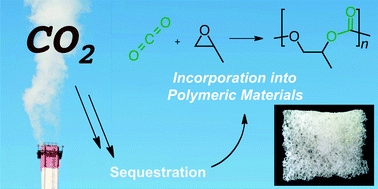In this tutorial review, Donald Darensbourg and Stephanie Wilson highlight the recent advances in the copolymerisation of carbon dioxide (CO2) with epoxides (oxiranes) to produce polycarbonates.

Darensbourg and Wilson conclude by highlighting the need for improved catalysts which can prevent the degradation of PPC in the presence of azide ions – specifically those catalysts with appended amines or ammonium salts.
Interested? Read the full article for free until the 2nd October 2012…
What’s new with CO2? Recent advances in its copolymerization with oxiranes, Donald J. Darensbourg and Stephanie J. Wilson, Green Chem., 2012, DOI: 10.1039/C2GC35928F
You may also be interested in this critical review article – free to access for 2 weeks:
Synthesis of cyclic carbonates from epoxides and CO2, Michael North, Riccardo Pasquale and Carl Young, Green Chem., 2010, 12, 1514-1539
Stay up-to-date with the latest content in Green Chemistry by registering for our free table of contents alerts.










